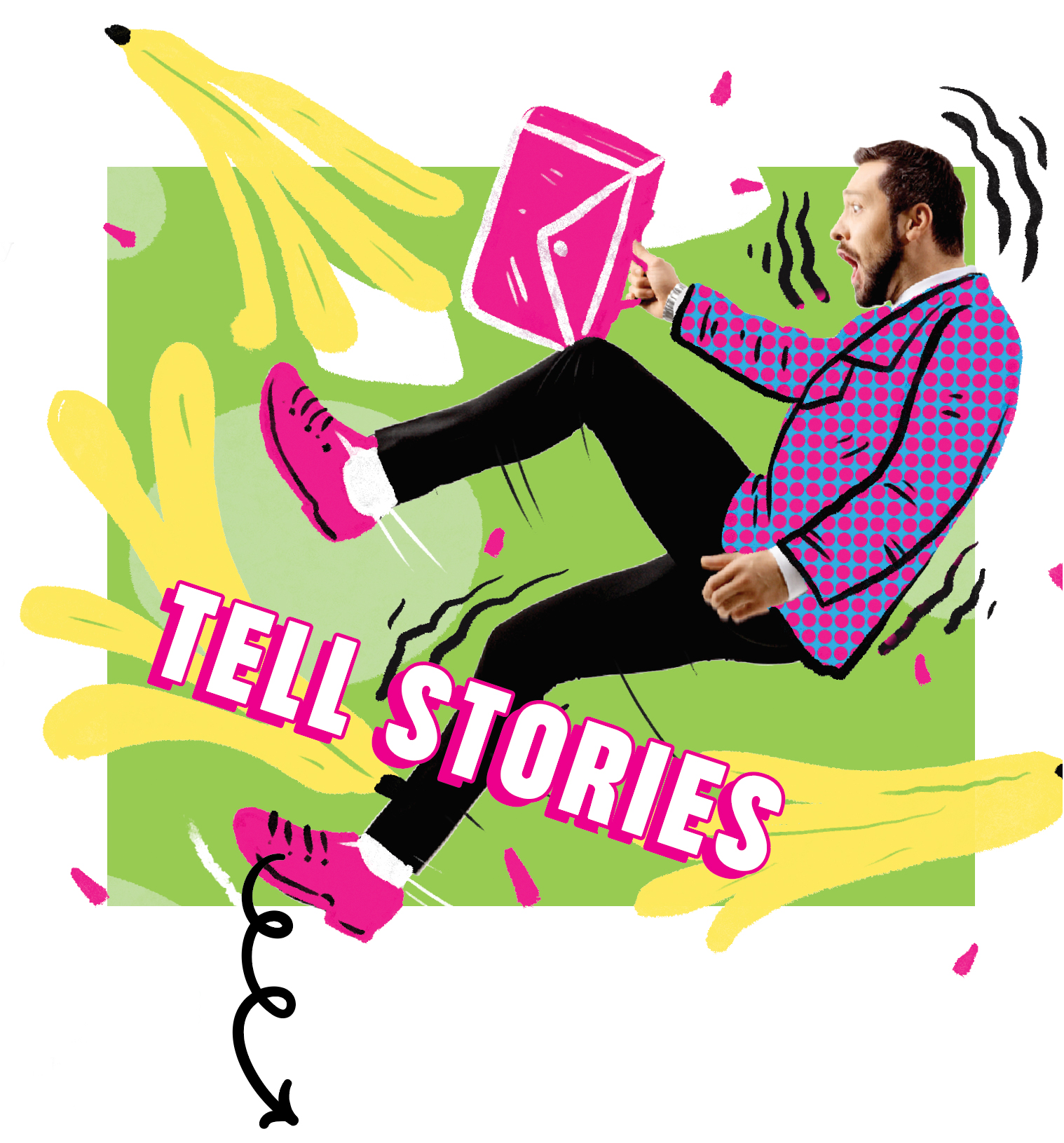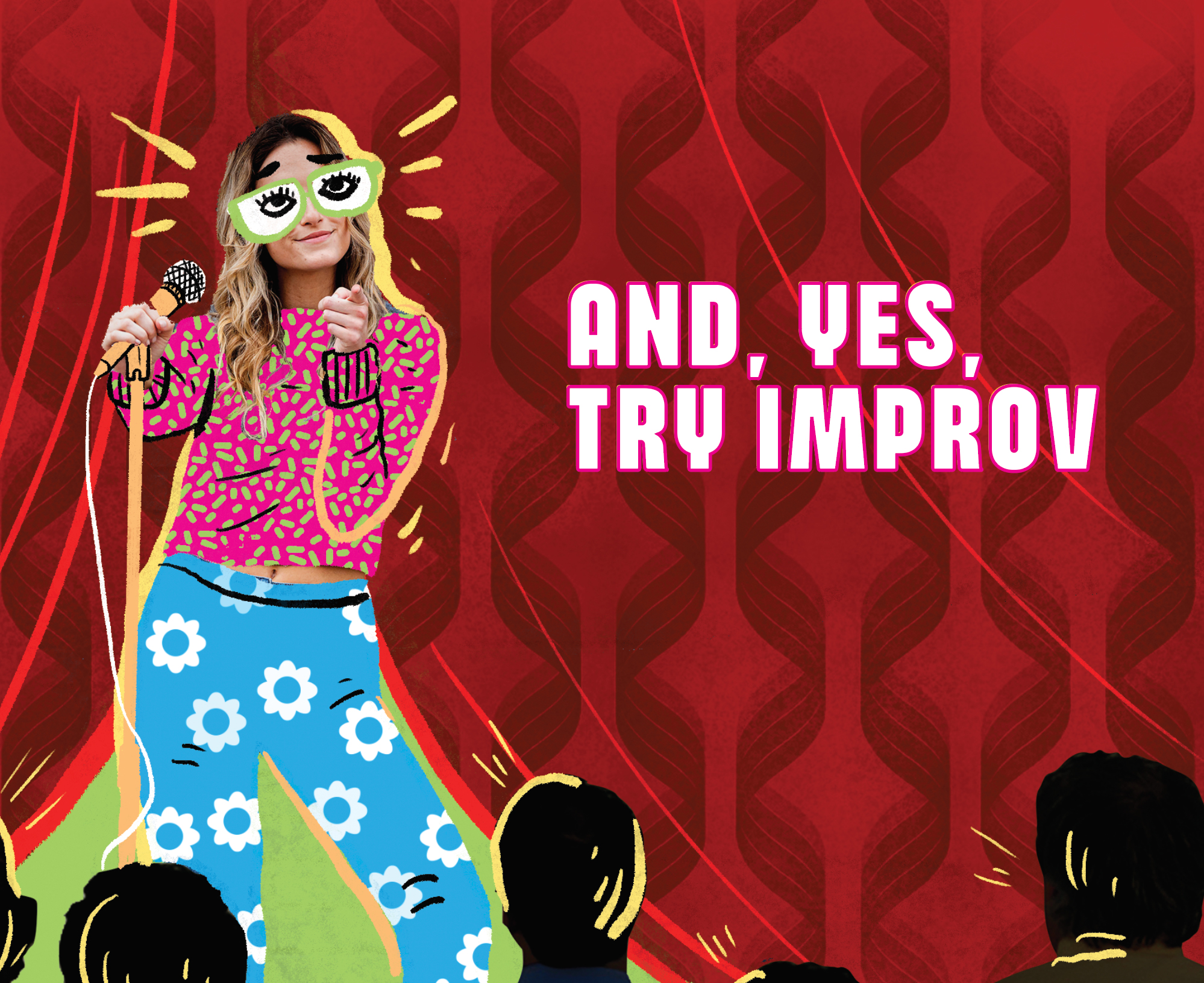STOP US IF YOU’VE heard this one, but the list of benefits from fostering an environment of levity in the workplace is staggering: It boosts sales and productivity, makes advertising memorable and leaders appear more competent. It transforms training into something enjoyable, increases employee retention and attracts eager new hires. It flattens hierarchies, enhances collaboration and encourages people to take positive risks. It lowers stress and helps management communicate difficult messages. It essentially costs nothing (indeed, a 2011 study by researchers at Pennsylvania State University found that a good laugh activates the same regions of the brain that light up over a fat bonus check). Perhaps best of all, it just makes coming into the store or office more enjoyable for everyone.
So what’s the punch line? The rather depressing one that many bosses and workers, especially those in more “professional” settings, think humor is a bad idea … at least at their particular place of work. And that mindset is growing.
We are increasingly shying away from levity: according to some studies, we spend about a third as much time laughing as people did in the 1930s. Another study found 90% of corporate emails are completely devoid of humor, not even a chirpy sign-off.
What could explain this? There are three main reasons, all of which you’re probably quite familiar with: humor is viewed as inappropriate for the serious discourse of business or healthcare, it’s hard to do well (it feels like a divinely bestowed gift — you were either the funny kid in school or you weren’t), and it’s dangerous. Jokes are about a shared view of the world, an understanding of the same cultural and linguistic touchpoints and, crucially, a willingness to violate the same norms and laugh at the same things. When they bomb, it’s ostracizing. Worse, if the quip or story is viewed as offensive, it can damage the teller’s professional standing by making him appear lacking in both competence and intelligence.
Advertisement
In short, humor is one more wonder drug that can kill you. It’s not unwise to be wary of its power. But that doesn’t mean that humor somehow betrays your professionalism. “The research is clear: humor can be one of the most powerful tools we have for accomplishing serious things,” says behavioral scientist Jennifer Aaker, co-author of Humor, Seriously: Why Humor Is A Secret Weapon In Business And Life. “Gravity and levity aren’t at odds.”
Indeed, there’s a good argument that the higher the stakes, the more we need humor. (See: Ukrainian President Volodymyr Zelensky’s response to a U.S. offer to evacuate him: “I need ammo, not a ride.” The stakes don’t get much higher than facing an invading Russian army.) Dr. Adam Ramsey of Socialite Vision in Palm Beach Gardens, FL, puts it into context this way: “Sometimes it’s better to laugh than to cry. You can look at a problem and comic relief separates you from the issue so you can approach it rationally like you would if it wasn’t happening to you.”
But even in these more routine situations — the exam chair or the salesfloor — a little humor can do wonders, easing a patient’s anxiety or lowering a customer’s defenses.
“When I can hear the opticians and the patients laughing I know it will be a good sales day. Happy patients buy glasses!” says Amie Robinson of Spring Hill Eyecare in Spring Hill, TN. That’s not just the confidence of an experienced ECP; it’s a truth across industries and professions.
Aaker and her co-author Naomi Bagdonas quote Eric Schmidt, the former Executive Chair of Google, as saying: “I’ve learned (often the hard way) that the best way to be taken seriously is to not take yourself too seriously.”

In your own business, think of the first-time glasses wearer, brand-new presbyope, or a patient that just received a first-time diagnosis of eye disease. They’re likely feeling out of their depth and intimidated. A cheerless, all-business ECP is the last thing their overwhelmed mind wants to be dealing with at that moment.
Despite the weight of the occasion, this is often the perfect opportunity for a little irreverence. Mallory Haun at MetroSpecs Optical Shop in Fayetteville, NC, shares, “We utilize humor in our shop every day, from occasional goof ups on our part or to lighten the tension of a new glasses wearer.” Pablo E. Mercado at Highland Eye Boutique in Woodstock, GA, who believes that humor used smartly and appropriately is a valuable tool in his toolbox, likes to tell patients upon finalizing a sale to go to the hardware store and buy a bucket… “So they are able to catch the coolness dripping from their new eyeglasses,” he says. “At first they look confused, then they laugh when they get the joke. It also gets them excited about their new glasses. I even had a patient bring a toy bucket for his dispense once. Made my day!”
Disarmed, a customer or patient is then more likely to listen and more likely to be in the mood to buy. Done right, humor has the power to build bridges instantly, lull the customer into surrendering useful personal information and overcome objections.
Dr. Scott Mann at Invision in Christiansburg, VA, agrees, “Humor is vital to the human experience so it is great in the office! When I send out a patient for a cataract consult I remind them ‘Now, everyone you know is all of a sudden going to become a cataract expert.’ After they think about that for second, most laugh and say ‘I know, I will ask you if I have any questions.’ Humor helps make the point.”
“Humor makes you likable and people want to buy from people they like because they trust them and have more confidence in them,” says sales trainer Jeffrey Gitomer. “The end of laughter is followed by the height of listening.” Or as John LaShorne of Brown County Eye Care in Nashville, IN, states, “People do business with people. Getting the person to like and trust you is essential.”
But I’m not that sort of funny, you say. Few of us are. Mercifully, it’s not that hard to get better.
Humor is a skill, which means it can be learned. And besides, you don’t need to be professional comedian level funny, you just need to be funnier than the dour ECP down the road.
“Just as you don’t need to be Phil Mickelson to do well at the company golf outing, you don’t need to be Amy Schumer, Ali Wong, or John Mulaney to use humor well in the workplace,” writes Brad Bitterly and Alison Wood Brooks in Sarcasm, Self-Deprecation, And Inside Jokes: A User’s Guide To Humor At Work. Studies even show that something as simple as a lighthearted line at the end of a sales pitch — “My final offer is X and I’ll throw in my pet frog” — can increase customers’ willingness to pay nearly 20% more.“Really let it sink in how bad that joke is. The bar is so low,” says Bagdonas.
For Mark Twain, arguably America’s greatest wit, humor wasn’t some optional extra. It was the key to a good life. “Humor is the great thing,” he wrote. “The saving thing. The human race has only one really effective weapon and that is laughter.”
In the following pages, we provide tips from your fellow ECPs, comedians and academics to help you up your humor game, and your business operations as well.
Look for True, Not Funny
If you want to have more humor in your life, don’t look for what’s funny, just look for what’s true, says Naomi Bagdonas, a lecturer at Stanford Graduate School of Business and coauthor of Humor, Seriously. “So become an observer of your life. Look for little oddities or incongruities. It’s not about being funny per se but using humor in small intentional ways.” Jerry Seinfeld, arguably the most successful American comedian of the last few decades, has made a sparkling career from this sort of observational humor: What’s the point of straws? Or one-speed bikes? Why do your kids have names like stars? His genius is in seeing the funny in the thing in front of your nose. “I live for humor. It is the basis of my business,” shares Dr. Cynthia Sayers of EyeShop Optical in Lewis Center, OH, “I don’t tell lame eye jokes, more like find humor in the world we live in.”
Bagdonas agrees: “Just look around your life and notice these simple true things.” Such an approach also leverages the psychological principle of priming, which states our brains are wired to see what we’ve been set up to expect. Start looking for the humorous and you’ll find it everywhere. In your commute, in your efforts to bring life to heel, in the mirror.

The safest humor involves personal stories because they are guaranteed to be original. And they can be practiced and perfected in your own highly personalized style. Keep in mind there’s nothing funny about a confident person who’s doing well. The best stories involve those when life threw you a banana peel. Your new trainee tossing a one-carat diamond into the dumpster is not funny today … but it will be when you get to Vegas and talk shop with other store owners. As the late humorist Jeanne Robertson wrote in Don’t Let The Funny Stuff Get Away, humor is not about one-liners or being able to tell jokes, it’s about accepting things about yourself that can’t be changed and finding the humor in the situations around you. Final key technical point: Crafting a funny story involves knowing the ending and working backward. Keeping the punchline in mind will help you determine which details are essential for your story. If it doesn’t directly set up your punch line, cut it.
Comedy is Writing
Everyone knows that comedy is essentially a combination of what you say and how you say it — your material and your delivery. The often unmentioned third element is how you write it. Explaining his creative process to podcaster Tim Ferriss last year, Seinfeld mentioned dropped phone calls as an example. “It’s so stupid, people saying ‘I don’t know what happened just then,’ I think, let me see if I can create something: it’s like an archery target from 50 yards away, so I take out my bow and say, let’s see if I can hit that. I’ll write something and I’ll go back to it the day after and see if it I like it … I love to spend an inordinate amount of time refining and perfecting it until it has a pleasing flow to my ear. And then I can’t wait to say it publicly. It’s like an experiment, and the audience dumps data on it. And it’s back to the re-write process.”
The Rule of Threes
Three is the smallest number of elements required to create a pattern. Once you start looking for it, you’ll see it everywhere (“Life, Liberty and The Pursuit Of Happiness,” “Blood, Sweat and Tears,” “Sex, Drugs and Rock ‘n’ Roll”). It works in humor when the pattern ends with something unexpected. “It seems that audiences are trained to laugh at the third item as well,” says David Nihill, the author of Do You Talk Funny. “It’s strange but true.” Think of every “Three men walk into a bar…” joke you’ve ever heard.

The bits comics do on stage have the feel of something raw and spontaneous. But good comics leave nothing to chance: every word, sentence and gesture has been rehearsed and tested to find where the best laugh lines are. Yes, there are naturally funny people but to get better requires practice. Find a space at home or work and tell your stories while recording them. “If it makes you laugh even a little on playback, then you have something good to work with,” says Nihill. True, you’ll probably hate the sound of your voice, but you’ll get used to it. The family pet dog can make a good first audience. But soon you’ll want to run your “bits” by co-workers, trusted friends or old customers to see if they’re actually funny or instead prone to unintended interpretation. “If most of them laugh, keep it for your repertoire; if the majority groan, drop it. You’ve saved yourself some future pain.”
Keep it Short
Comedy is in the details but you don’t want to overdo it, says San Francisco comic Reggie Steele: “Just enough to set the scene,” adding your description should be “as if you were talking to a blind person.” William Shakespeare may have written “Brevity is the soul of wit,” but funny guys have known you need to get to the funny fast forever. Writing comedy isn’t really about writing, it’s more about editing,” says Nihill.
Start Small
As you embark on your journey to find and share the funny, take tiny steps — your brain works better and you make better choices when you you’re in your comfort zone. You’re also likely to approach customers more positively when it’s in a situation where you’ve had success before, writes Marcus Buckingham in The One Thing You Should Know.”

Practice with Bottles
Comedian Matt Morales recommends practicing your presentation or pitch with a bottle in each hand to get accustomed to speaking with your hands out in front of you. It looks natural but initially will make you feel like Jon the Robot.
Leverage Existing Rituals
Not all humor needs to be of the high-stakes interpersonal type. It can be inserted in the small existing rituals of a business. Explains Bagdonas says: “Oftentimes a manager can think, oh gosh, well, I have to do something totally big and bold to have some levity here. And actually, sometimes the more effective way is to say, what are the rituals you already have? Are there team communication channels? Are there all hands or daily standup meetings? And could you add a little bit of humor into those?” This can include anything from using light-hearted sign-offs in emails to getting staff to play “two truths and a lie” at monthly meetings. The Wall Street Journal recently reported about the “corporate jargon days” that employees at consultancy Silver Lining Ltd. held on a monthly basis when they tried to use as much vague, bureaucratic language as possible. The goal: to goad the group to break the buzzword habit. “Before going to lunch, we would joke about having a three-hour strategy session to do a SWAT analysis of Subway vs. McDonald’s, considering how we could all get into alignment and move forward together as a team,” an employee told the paper. After the lesson was absorbed, they dropped the ritual. At Northwest Hills Eye Care in Austin, TX, Dr. Laura Miller, shares they mark meetings with humor, “We do a ‘dad joke’ in our office meetings just to give a good eye roll or get a giggle.”

Context Matters
Any rules of thumb for using humor must include a caveat: Context matters. Conversational dynamics can vary profoundly from person to person, group to group and situation to situation. These factors are tricky to navigate and make it difficult to know whether your humor attempt is being helpful or a distraction. (And when you’re the boss, staff will often laugh politely even if something isn’t funny or is in poor taste, creating an unreliable feedback loop.) A joke can work even in a somber situation if it relieves tension. A boss who jokes after a round of layoffs that he’s going to have to get a smaller yacht is likely to come across as insensitive and tone deaf, says Andrew Tarvin, a New York City workplace coach and author of Humor That Works. “Before you try to say something humorous try to determine the type of person you’re addressing — the wrong humor will sink you as fast as the right humor will boost your chances of a sale,” says Tarvin. Learn to read the nuances of co-workers’ and customers moods and attitudes and pick the right context for jokes, he says, in his book How To Fail At Almost Everything And Still Win Big. Be like Chris Gregg at Inver Grove Heights Family Eye Clinic in Inver Grove Heights, MI, and ABT – Always Be Testing. “Every time I talk to a patient, but I test the waters each time to see if they have a sense of humor.”
Know Your Humor Style
Bagdonas and Aaker contend that everyone has one of four humor styles:
- Stand-Up: Bold, irreverent, and unafraid to ruffle a few feathers (Example: Wanda Sykes).
- Sweetheart: Earnest, understated, and use humor that lightens the mood (Example: James Corden).
- Sniper: Edgy, sarcastic, nuanced — masters of the dig (Example: Michelle Wolf).
- Magnet: Expressive, charismatic, and easy to make laugh (Example: Jimmy Fallon).
To determine your category, you can take their test here.
“The more you understand everyone’s styles, the easier it is to read the room and know when to drop that perfectly timed frog joke,” says Aaker. You’ll also be better able to mitigate risks. For example, sweethearts and magnets need to watch out for excessive self-deprecation that can undermine their reputations, while standups and snipers have to make sure they don’t offend or alienate.”

Keep a Journal
Keep “A Funny Thing Happened On The Way To Work” file or journal to write down humorous things or events so you can remember them. It’s an assignment all Aaker and Bagdonas students are given at Stanford. “All that you do is you go through your day, and you jot down any moment when you laughed, or any moment when you had shared laughter,” Aaker says. Typically, their students report experiencing much more joy and laughter in their lives by the seventh day of this practice, she says.
Make Fun of People Correctly
In other words, make fun of what people do, not who they are. If you’re on the fence about whether to say a joke, don’t use CK Louis as your guide, says Bagdonas. “Don’t ask yourself, will this make me sound funny? Instead ask, how will this make other people feel? The goal isn’t to get a laugh, it’s to connect, to make people feel lighter and more at ease.” Most people know the taboos: Divisive racist, ethnic or sexist jokes are out. Not only do you risk losing the sale but you could damage the reputation of your business (and if it’s a sexist joke, find yourself on the wrong end of a lawsuit). But you need to go further than simply watching out for someone’s background or identity. “Don’t punch down. So that means never making fun of someone of lower status,” says Aaker. Finally, check your distance — how close are you to the person you are making fun of? “I can make fun of my mother but not your mother,” says Aaker.
Bounce Back The first rule when a joke bombs is don’t double down, don’t repeat the joke, thinking people must not have heard it. They most likely did. And don’t explain it. Instead, skilled humorists quickly turn the joke on themselves, says Michael Kerr, a workplace trainer and author of The Humor Advantage, adding that you should make sure to deliver it in a warm, non-sarcastic tone. For example: “It takes a special human being to do what I just did,” or “This is great. Today was going to well anyway,” or “Thanks, I’ll be here all day.” “Make them laugh with you or at you!” says Alexander Saper of Great Glasses in Houston, TX.
Advertisement
As for those times when you cross the line and say something inappropriate, “that’s a very different scenario,” says Bagdonas. “The most important thing is genuinely acknowledge it and get curious about your blind spot. Where was the empathy-fail that led you to this humor fail? So that you can learn from it and not make the same mistake in the future.”
Be InclusiveInside jokes can signal closeness or camaraderie, making people feel pleased to be in the loop. But they can also draw fault lines in an organization, making some people feel awkward and excluded. The research on this kind of humor is clear: When group cohesion is important, tell jokes that everyone can understand.
Use Humor That Has a PointOur brains don’t like or recall boring things, which is why funny ads are remembered. However, there are two things to keep in mind when going for a humorous approach in your advertising: 1) studies show your claims may not be taken as seriously; and 2) the humor needs to reinforce the principal point of your ad. “Here’s the litmus test,” says Wizard Of Ads author Roy H. Williams: “If remembering the humor forces you to recall the message of the ad, the humor is motivated. Good job. But if recalling the humor doesn’t put you in memory of the ad’s main point, the humor is unmotivated and will make your ad less effective. Sure, people will like the ad. They just won’t buy what you’re selling.”

Speaking and presentation coach Darren LaCroix says there are three keys to improving humor delivery — stage time, stage time, and stage time. Humor workshops for businesspeople, and especially improv clubs, have exploded in recent years, and while yes, improv is little more than looking silly and exposed in front of strangers, the benefits are claimed to go way beyond getting more comfortable with public speaking. (One MIT study found a group of improv comedians generated 20% more ideas than professional product designers did — apparently practicing improv develops your ability to create). On top of a tougher skin, improv teaches specific techniques to think faster and funnier on your feet, the best known of which is the “and, yes” extension to allow you to further riff on an idea. It even makes for a great team building exercise…
Is Sarcasm Your Second Language?
Sarcasm has a reputation for being a low, mostly negative form of humor favored by teenagers when engaging with their parents or humiliating a peer. But studies show that when used appropriately it can boost creativity and expand the way we think about things; because it involves saying one thing and meaning another, interpreting it necessitates a higher level of abstract thinking. But it requires a cautious approach and works best when trust and playfulness has been established between parties, otherwise a wrongly-placed sarcastic comment can appear flippant or cruel. According to Professor Adam Galinsky of Columbia Business School. “Until you’ve established trust, it’s best to communicate with respect,” he writes in the Harvard Business Review.
Humor for Negative FeedbackIt can be tempting to fall back on a joke to lighten the mood or stop someone from getting overly defensive — such as teasing someone about running up a $75 tab on the hotel minibar at a trade show. However, couching criticism in the form of a joke can lessen its impact. A Harvard Business School study found that although humorous complaints were better received than serious ones, they were also seen as more benign, and people felt less compelled to take action to rectify the problem. “If a manager jokes about a subordinate’s slipping performance, the employee may think either that his performance hasn’t been slipping or that the situation isn’t a big deal. If it were, why would she be joking about it?” Brad Bitterly and Alison Wood Brooks write in the article.

It’s OK to Chicken Out
If you don’t think you can land jokes at work, or you’re too nervous to try, that’s OK. Not everyone is meant to be funny, just as not every attempt at humor will be successful. (Even professional comedians have “bits” that bomb.) But you can still incorporate levity into your work life by doing something simple: appreciating other people’s humor, say Bitterly and Wood Brooks. “Be quick to laugh and smile. Delight in the absurdity of life and in the jokes you hear. A life devoid of humor is not only less joyful — it’s also less productive and less creative, for you and for those around you.” At the end of the day, it Dr. Robert M. Easton Jr. in Oakland Park, FL, sums it up perfectly: “I rarely tell a joke but I’m welcome patients telling them to me.”
Advertisement